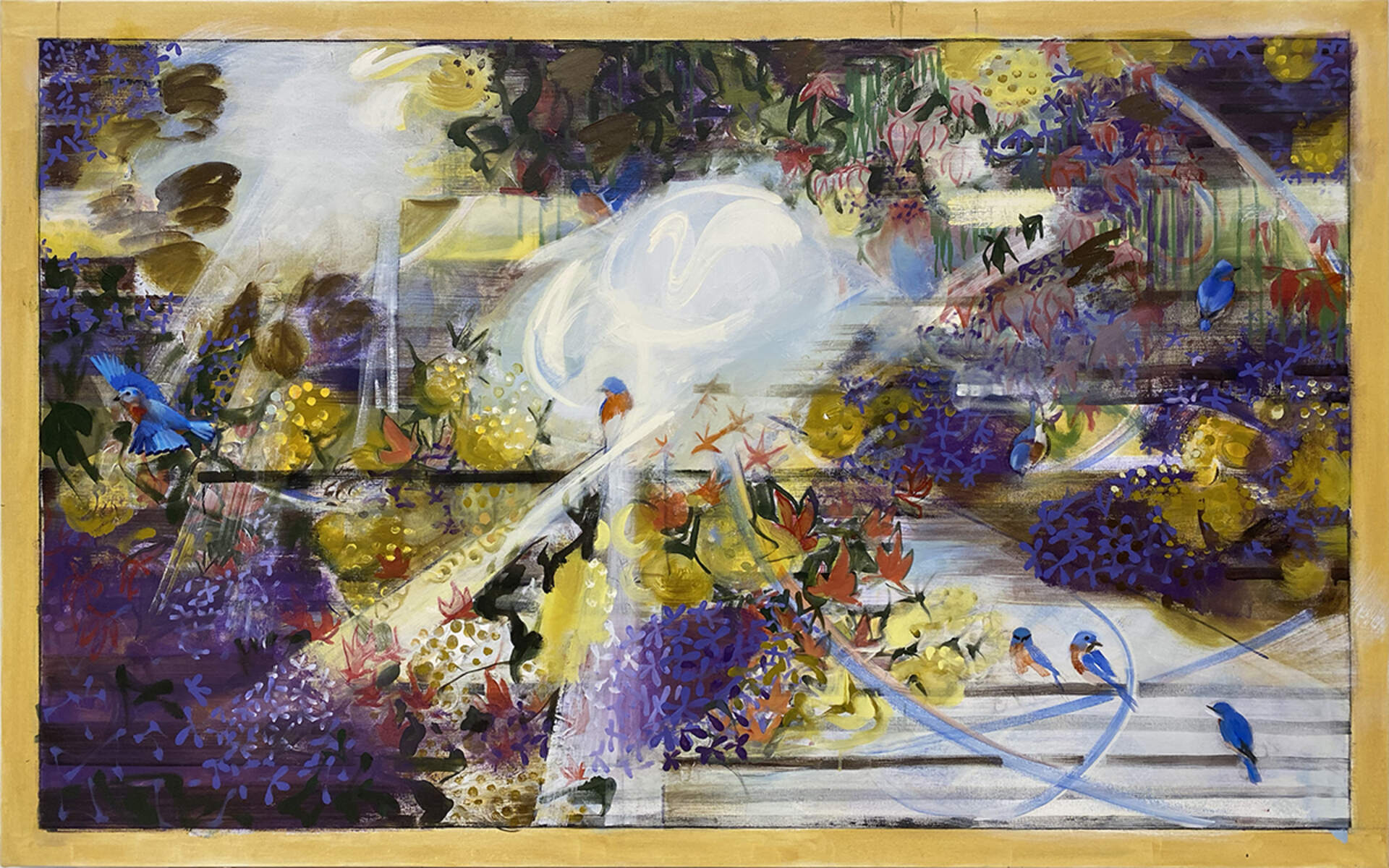Mike Glier (b. 1953)Bluebirds Flocking as Fall Approaches
2022
acrylic and charcoal on canvas
45 x 72 inches
Courtesy of Downing Yudain, North Stamford, CT
PERCEPTION AND THE UMWELT
MG: Nancy, the concept of the Umwelt was first developed by the German biologist, von Uexküll in the late 19th century. Is there any indication that Burchfield might have known about the Umwelt? And if he did not know specifically about the concept, did he demonstrate interest in understanding how other living things might perceive the world differently from humans in accordance with their unique perceptual capabilities?
NW: Good questions…Burchfield never used the term “Umwelt” in his journals, even though he studied German in school. A term he did use frequently is “Vorfrühling,” which translates to “Early Spring.” He describes this exciting time of seasonal change every year. It always triggers youthful memories, such as a warm day in March wandering with friends to “the ‘Meander’ or ‘Little Beaver’ creek…sitting on a bleached out grassy bank with the hot sun sending its stupefying rays over us, as spiders scampered in the grass; the babble of the stream increased the drowsy feeling. I think of days spent in rambling around dark pine-hollows, where the unmelted ice makes it chilly, and then in the middle of the afternoon, coming out into the sunlight world & stopping at some mud-splattered village to buy a few cakes or chocolate. How strange & far off this village seems, made magic by the slanting sunlight.”
Burchfield’s empathetic connection to the natural world made him curious. He wondered how flowers, trees, and birds perceived the world. In fact, in 1919, after his military service during World War I, he painted a series about life from the perspective of birds. His dealer convinced him that the series was not a viable subject, so he destroyed them in March 1932, noting he burned some “atypical works from 1919, such as the series depicting life from the perspective of birds or that used birds as metaphors for nature’s seasonal rhythms.” Regretting this, he recreated some of those paintings in 1963 from memory because such lingering ideas persisted.
MG: Do we have images of the 1963 remakes?
NW: Yes! The Burchfield Penney Art Center owns New Life, which he described as a “Birdling inside a bud greatly enlarged.” The backdrop is a hilltop filled with crocuses and a landscape view that resembles much of Thomas Cole’s grand panorama, View from Mount Holyoke, Northampton, Massachusetts, after a Thunderstorm—The Oxbow (1836).
MG: The concept of Umwelt is such a profound way for human beings to reassess other living creatures and learn to respect them for their awesome powers that often surpass our own. The diversity of life is a marvel and a little humility is in order! Burchfield claims that this picture is from the perspective of the baby bird, but I’m not sure I see it? Do you?
NW: Yes. First consider the surrealism of an x-ray vision of the red sumac revealing the hatchling as if a plant could give birth to a bird. Or, could what appears to be sumac be the bird’s perspective of its mother’s protective wing? Is this a bizarre union of flora and fauna? However we interpret this scene, it’s clearly not the perspective of a human being.
MG: One thing is for certain, Burchfield rarely puts humans into his landscapes. I’m interested in decentering the human image in art and consider Burchfield a herald of this contemporary idea. Humans have been the center of artistic expression forever, so in this time of ecological emergency, perhaps it’s time to put other living things at the center of discussion.
NW: I think Burchfield’s paintings are timeless, unlike work by many of his contemporaries, because he chose the symbolism and metaphors of trees, wildflowers, birds, insects, and other creatures to represent humans. He knew what he wanted to accomplish by the age of 21, saying “I hereby dedicate my life and soul to the study and love of nature, with the purpose to bring it before the mass of uninterested public, that they may see and become familiar with the endless number of nature’s beauties, wherein lies my greatest happiness. If I can bring only a few serious-minded people to see how vital nature is, besides being beautiful, I shall be content.” He wanted the public to see through his eyes and share the experience. Human figures would diminish the effect. I sense a similar attitude in your work, like in your bluebird painting.
MG: On an October morning I walked through a flock of bluebirds along a hedgerow that was full of asters and goldenrod. The bluebirds did not rise up as a group as I walked amongst them. Instead, individuals lifted and settled a few yards ahead and then hop-scotched back as I continued to approach to resettle where they had been. It was like passing through a cloud whose molecules were stirred but whose shape and position were unaffected by my passing. I made Bluebirds Flocking as Fall Approaches to commemorate the moment. If I’d included myself surrounded by the flock, the picture would have been about a man engaging nature. Without me, the protagonists are the birds and their behavior as a group, which I find more interesting and urgent as a subject.
